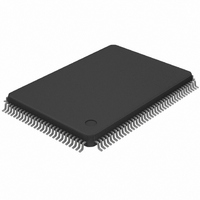MAX4356ECD+T Maxim Integrated Products, MAX4356ECD+T Datasheet - Page 38

MAX4356ECD+T
Manufacturer Part Number
MAX4356ECD+T
Description
IC VIDEO CROSSPOINT SWIT 128TQFP
Manufacturer
Maxim Integrated Products
Datasheet
1.MAX4356ECD.pdf
(41 pages)
Specifications of MAX4356ECD+T
Function
Video Crosspoint Switch
Circuit
1 x 16:16
Voltage Supply Source
Single, Dual Supply
Voltage - Supply, Single/dual (±)
5V, ± 3 V ~ 5 V
Operating Temperature
-40°C ~ 85°C
Mounting Type
Surface Mount
Package / Case
128-TQFP, 128-VQFP
Lead Free Status / RoHS Status
Lead free / RoHS Compliant
16 x 16 Nonblocking Video Crosspoint Switch
with On-Screen Display Insertion and I/O Buffers
cable. The series 75 resistor is called the back-match,
reverse termination, or series termination. This 75
resistor reduces reflections, and provides isolation,
increasing the output capacitive driving capability.
The MAX4356’s unique digital interface simplifies pro-
gramming multiple MAX4356 devices in an array.
Multiple devices are connected with DOUT of the first
device connecting to DIN of the second device, and so
on (Figure 10). Two distinct programming modes, indi-
vidual output address mode (MODE = 0) and complete
matrix mode (MODE = 1), are selected by toggling a
single MODE control pin high or low. Both modes oper-
ate with the same physical board layout. This allows ini-
tial programming of the IC by daisy-chaining and
sending one long data word while still being able to
address immediately and update individual locations in
the matrix.
In Individual Output Address Mode, the devices are
connected in a serial bus configuration, with the data
routing gate (Figure 3) connecting DIN to DOUT, mak-
ing each device a virtual node on the serial bus. A sin-
gle 16-bit control word is sent to all devices
simultaneously. Only the device with the corresponding
chip address responds to the programming word, and
updates its output. In this mode, the chip address is set
through hardware pin strapping of A3–A0. The host
then communicates with the device by sending a 16-bit
word consisting of 2 don’t care MSB bits, 4 chip
address bits, and 10 bits of data to make the word
exactly 2 bytes in length. The 10 data bits are broken
down into 4 bits to select the output to be programmed;
1 bit to set the output enable, 1 bit to set gain, and 4
bits to select the input to be connected to that output.
In this method, the matrix is programmed one output at
a time.
In Complete Matrix Mode, the devices are connected in
a daisy-chain fashion where n x 96 bits are sent to pro-
gram the entire matrix, and where n = the number of
MAX4356 devices connected in series. This long data
word is structured such that the first bit is the LSB of
the last device in the chain and the last data bit is the
MSB of the first device in the chain. The total length of
the data word is equal to the number of crosspoint
devices to be programmed in series, times 96 bits per
crosspoint device. This programming method is most
often used at startup to initially configure the switching
matrix.
38
______________________________________________________________________________________
Individual Output Address Mode (Mode 0)
Complete Matrix Mode (Mode 1)
Matrix Programming
The MAX4356 guarantees operation with single +5V
supply and gain of +1V/V for standard video input sig-
nals (1Vp-p). To implement a complete video matrix
switching system capable of gain = +2V/V while operat-
ing with +5V single supply, combine the MAX4356
crosspoint switch with Maxim’s low-cost, high-perfor-
mance video amplifiers optimized for single +5V supply
operation (Figure 11). The MAX4450 single and
MAX4451 dual op amps are unity-gain-stable devices
that combine high-speed performance with Rail-to-
Rail
extends beyond the negative power-supply rail (ground
in single-supply applications). The MAX4450 is avail-
able in the ultra-small 5-pin SC70 package, while the
MAX4451 is available in a space-saving 8-pin SOT23.
The MAX4383 is a quad op amp available in a 14-pin
TSSOP package. The MAX4380/MAX4381/MAX4382
and MAX4384 offer individual output high-impedance
disable making these amplifiers suitable for wired-OR
connections.
Rail-to-Rail is a registered trademark of Nippon Motorola, Ltd.
®
outputs. The common-mode input voltage range
+5V Single-Supply Operation with
A
V
= +1V/V and +2V/V











